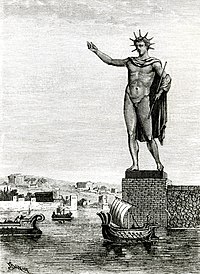Chares of Lindos | |
|---|---|
 The Colossus of Rhodes, built by Chares of Lindos | |
| Born | before 305 BC |
| Died | c. 280 BC Rhodes, Greece |
| Occupation | sculptor |
| Years active | ?-c.280 BC |
| Notable work | Colossus of Rhodes |
Chares of Lindos (/ˈkɛəriːz/; Greek: Χάρης ὁ Λίνδιος, gen.: Χάρητος; before 305 BC – c.280 BC) was a Greek sculptor born on the island of Rhodes. He was a pupil of Lysippos.[1] Chares constructed the Colossus of Rhodes in 282 BC, an enormous bronze statue of the sun god Helios and the patron god of Rhodes.[2] The statue was built to commemorate Rhodes' victory over the invading Macedonians in 305 BC, led by Demetrius I, son of Antigonus, a general under Alexander the Great. Also attributed to Chares was a colossal head which was brought to Rome and dedicated by P. Lentulus Spinther on the Capitoline Hill, in 57 BC (Pliny, Natural History XXXIV.18).[3]
The Colossus of Rhodes is one of the Seven Wonders of the Ancient World,[4] and was considered Chares's greatest accomplishment, until its destruction in an earthquake in 226 BC.[5]
The work may have been completed by Laches, also an inhabitant of Lindos.[6] [7][8]
In popular culture
[edit]- L. Sprague de Camp's novel The Bronze God of Rhodes is written as Chares' memoirs of the Siege of Rhodes and the building of the Colossus of Rhodes.
- Asteroid 236746 Chareslindos, discovered by Vincenzo Casulli in 2007, was named after the ancient Greek sculptor.[9] The official naming citation was published by the Minor Planet Center on 4 November 2017 (M.P.C. 107121).[10]
- Chares, called by the Italian version of his name (Carete), appears in the 1961 film The Colossus of Rhodes, portrayed by Félix Fernández.
References
[edit]- ^ Van Gelder, Lawrence (10 August 2006). "Arts, Briefly". The New York Times. Retrieved 19 December 2007.
- ^ "Information about the Colossus of Rhodes". rhodos-travel.com. Retrieved 19 December 2007.
- ^ "The Ancient Library". ancientlibrary.com. Archived from the original on 21 May 2008. Retrieved 16 May 2008.
- ^ "The Colossus of Rhodes". unmuseum.org. Archived from the original on 8 April 2011. Retrieved 19 December 2007.
- ^ "Colossus of Rhodes". corrosion-doctors.org. Retrieved 19 December 2007.
- ^ Sextus Empiricus, Against the Logicians 1.107-8; a much later work by a philosopher, not a historian.
- ^ "A dictionary of Greek and Roman biography and mythology (ed. William Smith)". perseus.tufts.edu. Retrieved 16 May 2008.
- ^ Elmes, James (1824). "A general and bibliographical dictionary of the fine arts". books.google.se. Retrieved 16 May 2008.
- ^ "236746 Chareslindos (2007 LP)". Minor Planet Center. Retrieved 1 September 2019.
- ^ "MPC/MPO/MPS Archive". Minor Planet Center. Retrieved 1 September 2019.
External links
[edit]- . Encyclopædia Britannica. Vol. 5 (11th ed.). 1911. p. 859.
Well, that’s interesting to know that Psilotum nudum are known as whisk ferns. Psilotum nudum is the commoner species of the two. While the P. flaccidum is a rare species and is found in the tropical islands. Both the species are usually epiphytic in habit and grow upon tree ferns. These species may also be terrestrial and grow in humus or in the crevices of the rocks.
View the detailed Guide of Psilotum nudum: Detailed Study Of Psilotum Nudum (Whisk Fern), Classification, Anatomy, Reproduction